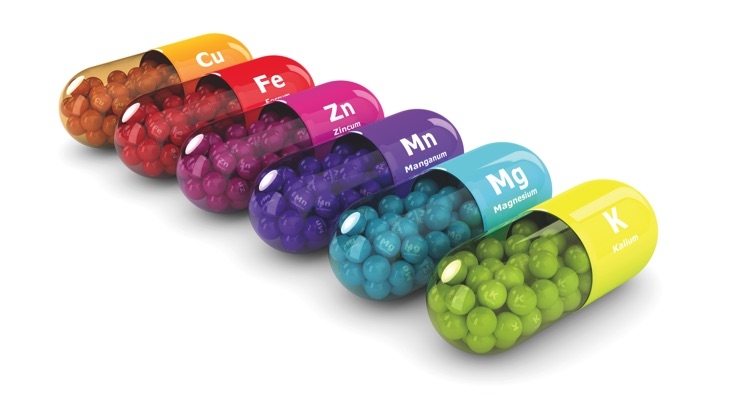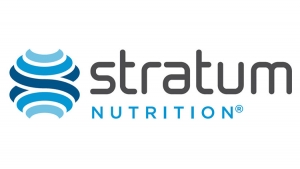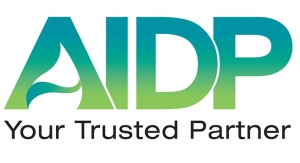Lisa Olivo, Associate Editor01.03.17
Mineral-based dietary supplements remain a well-established and consistent portion of the nutraceutical market. Backed by a longstanding tradition of use and years of clinical research, these essential nutrients are commonly and confidently used by consumers. While trendy or more exotic ingredients require more extensive consumer education for market acceptance, most people are at least somewhat familiar with the benefits the more popular and established mineral ingredients can offer.
Stephen Ashmead, senior fellow of chelates research & development, Balchem/Albion Minerals, Clearfield, UT, stated that mineral sales have continued to perform well within the market. “Based on the 2015 Council for Responsible Nutrition (CRN) Consumer Survey, over 68% of adults in the U.S. take dietary supplements. Of these supplement users, usage was highest and confidence was strongest in the vitamin and mineral category. Calcium remains very strong with 24% of these consumers taking it.”
While calcium still leads in supplement sales, Mr. Ashmead observed an increased demand for magnesium supplements, predicting its continued growth in the years to come. “Iron and zinc also continue to perform well,” he observed. “Emerging and ongoing research is also bringing more attention to other minerals that have remained lesser known in the market, such as boron, copper, chromium, manganese, selenium and vanadium. As evidence continues to point to the benefits of these minerals, particularly when in chelated form, we expect to see their steady growth.”
Despite leading the category, calcium sales have taken a hit in the past year, according to SPINS data, dropping from around $204 million in 2015 to $188 million in 2016. Meanwhile, magnesium sales grew, accounting for over $90 million in sales in the U.S., up a strong 12.4% from 2015. Iron grew by 12.1% to $57 million; zinc was up by 7.1% to $14 million; potassium grew slightly (2.5%) to $9.7 million; and selenium remained somewhat static, earning $2.25 million (up just 0.9%).
Changing Calcium Climate
While calcium is the clear category leader, emerging studies suggesting a potential link to plaque buildup in arteries as well as heart damage has cooled sales. A study published in October 2016 in the Journal of the American Heart Association examined information from the Multi-Ethnic Study of Atherosclerosis, a project funded by the National Heart, Lung, and Blood Institute, which included more than 6,000 participants. The study focused on 2,742 of these participants who completed dietary questionnaires and two CT scans spanning 10 years apart. Among the trial’s outcomes was the finding that subjects taking calcium supplements showed a 22% increased likelihood of having their coronary artery calcium scores rise higher than zero over the decade, indicating development of heart disease. The researchers suggested that supplemented calcium, versus calcium consumed naturally through the diet, could be a risk to heart health.
However, a conflicting review and guidelines published on behalf of the National Osteoporosis Foundation and American Society for Preventive Cardiology found no link between calcium and increased cardiovascular disease (CVD) risk.
Taylor Wallace, PhD, CFS, FACN, and other leading researchers in the fields of nutrition, cardiology and bone health published a position statement in Annals of Internal Medicine in October 2016. “We found no evidence that supplemental calcium use, even at levels at or above the tolerable upper intake level (UL) contribute to heart attacks and/or cardiovascular disease,” said Dr. Wallace. “Our results were based on an exhaustive systematic review and meta-analysis of randomized controlled trials and prospective cohort studies prepared by independent researchers at Tufts University.”
Dr. Wallace further stressed that “calcium and vitamin D are vital for maintaining bone health across the lifespan and preventing osteoporotic fractures later in life. Adults who do not get at least three servings of dairy per day should supplement with 300 mg of calcium for each absent serving regardless of their age.”
Adding further substantiation to the known benefits of calcium, a recent study from the Journal of the American College of Nutrition (JACN), examined the safety and efficacy of a vitamin/mineral enhanced plant-sourced calcium supplement (AlgaeCal (AC)) in female consumers who had taken the supplement from 1 to 7 years.
Consumers who had completed at least one dual-energy x-ray absorptiometry (DEXA) bone mineral density (BMD) scan (N = 172) and/or blood chemistry test (N = 30) were offered complimentary repeat tests. Safety and efficacy were examined by annualized changes in a 45-measurement blood chemistry panel and changes in BMD.
No adverse effects or safety concerns were found in any of the within-group annualized changes in the 45 blood chemistries or in between-group changes in a similar control group (N = 5,070) who completed the same measurements. With regard to BMD, consistent and statistically significant within-group increases were found for the 7-year study period and when compared to expected BMD changes in three large databases or the combination (N = 25,885) of the three databases. Data from this study suggested the AlgaeCal supplement was associated with a significant annualized and linear increase in BMD of 1.04% per year, 7.3% over the 7-year study period. Researchers said these results stand in marked contrast to normative or expected changes of −0.4%/year from three different databases or in a combination of all three databases (N = 16,289).
In addition, the results showed that no evidence was found in cardiovascular risk as measured by adverse changes in blood lipids, nor was any evidence found of a diminished efficacy over the study period because gains in BMD were consistent and linear over the 7-year period, averaging 1.04% per year over the study. The results are also consistent with earlier short-term studies suggesting that the AlgaeCal supplement can facilitate significant increases in total body BMD in contrast to studies suggesting that calcium supplements can only slow down age-related declines in BMD.
Despite calcium’s established benefits to bone health, Nena Dockery, technical services manager, Stratum Nutrition, St. Charles, MO, speculated sales will continue to “rise and fall in popularity depending upon research findings and positive or negative media announcements.” Because calcium is so popular with consumers, and its benefits are well known, she suspected findings surrounding its use will continue to dominate the category’s media exposure. “Both positive and negative information surrounding calcium supplementation has been a frequent nutritional topic in the press,” she said. ”This has put a burden on suppliers to provide high quality products that are safe and effective.”
In light of the questions emerging regarding the benefits versus the safety of calcium supplementation, Ms. Dockery reported an increase in research focusing on how the body utilizes nutrients. “Changing the timing of supplementation (for instance spreading a daily dose throughout the day as opposed to taking it all at once) may make a crucial difference in how the body utilizes this specific mineral.”
Combining calcium with other ingredients is another way suppliers and formulators are stimulating the category. For example, AIDP, City of Industry, CA, offers the ingredient KoACT, which blends calcium with collagen to support bone health as well as bone flexibility.
“Calcium is a standard for bone health even though the larger segment is not growing due to the inability to show fast results. However novel ingredients such as calcium-collagen is gaining market share,” commented Mark Thurston, president at AIDP.
Magnesium on the Move
Magnesium is gaining headway as a leading mineral in the category, according to industry experts, with some suggesting it may surpass sales of calcium in the future.
Ms. Dockery linked magnesium’s success to its association with calcium, and its benefits for bone health. “Healthy individuals maintaining diets high in magnesium-rich foods such as dark green leafy vegetables, nuts, seeds and legumes rarely develop true magnesium deficiencies. However, suboptimal levels are fairly common and since magnesium is critical for over 300 biochemical reactions in the body, supplementation can be quite beneficial,” she explained.
Dr. Wallace also noted the rise of magnesium, referencing “a ton of new data showing benefits on heart and bone health.” Dr. Wallace co-authored a paper (Costello et al., 2016) that reviewed the health benefits of magnesium and called for serum magnesium to be clinically used as the reference standard. As magnesium was indicated as a shortfall nutrient that was under-consumed in the 2015 Dietary Guidelines Advisory, the paper stressed the need for an evidenced-based serum magnesium reference interval that reflects optimal health in relation to the current food environment and population. The authors linked magnesium deficiency to electrolyte, neurologic, musculoskeletal, and inflammatory disorders; osteoporosis; hypertension; cardiovascular diseases; metabolic syndrome; and diabetes. Studies have also demonstrated that magnesium deficiency is associated with several chronic diseases and that a reduced risk of these diseases is observed with higher magnesium intake or supplementation (Advances in Nutrition, 2016).
Scott Boyson, marketing manager, Trace Minerals Research, Ogden, UT, stated that increased awareness surrounding the importance of magnesium supplementation is leading to market growth. “All of our magnesium products are seeing success right now. There is so much new research about magnesium that it is putting a huge spotlight on the need for this mineral. With magnesium being such a critical mineral and being involved in over 300 metabolic processes in the body, people really feel results with it.”
Trace Minerals Research is the leading liquid magnesium brand in the natural channel according to SPINS, Mr. Boydon said. “We’re very proud that our Liquid Mega-Mag and Liquid Ionic Magnesium are number one and three in the top three best-selling liquid magnesium products. Our target audience is pretty broad with magnesium. Moms and heads of households from ages 24-55 are our target audience, but that could be expanded given the myriad of benefits of this mineral. Magnesium supplementation benefits everyone, including those looking for relief from leg cramps, stress, etc.”
Mr. Boyson added that nearly “70% of Americans don’t get the RDA of magnesium … but know how important it is to get an adequate intake of this critical mineral every day to support cardiovascular health, immune health, muscle and bone health, etc.”
AIDP offers the branded ingredient Magtein, which is a patented magnesium threonate designed to support cognitive function. The company’s website boasts research on the ingredient supporting its benefits for increasing the brain’s levels of magnesium, as well as enhancing synaptic density, learning abilities, working memory, and short- and long-term memory in a rat model.
The company lauded recent research published in the medical journal Neuropharmacology that explained the mechanism through which threonate works, and how it increases the amount of magnesium in the brain when subjects were administered magnesium L-threonate. Further, the study demonstrated that threonate is the only ligand to efficiently transport magnesium to neuron cells in the brain. In the study, L-threonate, the unique component of Magtein, drove magnesium into the fluids that surround the brain (cerebrospinal fluid), and then into neurons. This led to multiple changes including enhanced synaptic density and plasticity, as supported by a human clinical study.
In addition, the company noted increased brain magnesium levels have been shown to support restful sleep and balanced mood.
Iron’s Strengths
Iron was once the most recognized mineral supplement, according to Stratum’s Ms. Dockery, but its popularity has been eclipsed. “This is partially due to an increase in the aging population,” she explained. “Post-menopausal women and older men do not usually need iron supplementation, as higher than normal iron levels can be associated with cardiovascular events. Also, in most cases, iron is part of a multivitamin/mineral supplement given to children and young adults, who are most vulnerable to iron deficiency, so a separate iron supplement isn’t necessary.”
While its common inclusion in multivitamins has made its need as a stand-alone supplement diminish, iron is still considered essential for human health, especially when it comes to prenatal care, impacting both mother and child.
Mr. Ashmead with Balchem/Albion Minerals cited a study published in the Journal of Nutrition (Abioye, et al. 2016) that showed prenatal iron supplementation not only decreased the risk of maternal iron deficiency anemia, but also increased the likelihood of infant survival and pregnancy outcomes. Researchers also concluded that “iron intervention may also provide greater health benefits,” according to Mr. Ashmead.
In another meta-analysis (Low, et al. Cochrane Database of Systematic Reviews, 2016) it was found that daily supplementation of iron in menstruating women, including teenagers (ages 12-50), improved energy as measured by increases in exercise performance in addition to reduction in prevalence of iron deficiency and anemia. Mr. Ashmead added, “Finally, Li, et al., (Journal of Nutrition, 2016) found that the trace minerals in maternal breast milk are associated with anthropometric measurements in infants.”
Selenium, Boron, Zinc & More
Soil depleted in minerals such as selenium has made supplementation essential, according to AIDP’s Mr. Thurston. Further, he noted that selenium was recently recognized as an essential mineral to be included in infant formula. “The bottom line is that in a perfect world, getting all your nutrients from good whole foods is the ideal, however, in today’s society it’s not possible,” he explained. “High quality, science-proven supplementation is key.” AIDP is a distributor Cypress Systems’ SelenoExcell selenium, which Mr. Thurston said is growing in popularity “because of the lack of selenium in the human diets.”
Mr. Ashmead, cited a 2016 study published in Biological Trace Element Research linking selenium, along with zinc and copper, with the prevention of periodontitis. Researchers “found that zinc, selenium and copper in balanced levels are required to prevent the progression of periodontitis. They indicate that these minerals are part of the antioxidant enzymes that prevent reactive oxygen species-induced destruction of tissues.”
Meanwhile, research surrounding boron supplementation has also yielded benefits for antioxidant activity. An article published in the Journal of Trace Elements in Medicine and Biology (2016) “found that boron supplementation in Wistar rats influenced immune and antioxidant responses,” noted Mr. Ashmead. Researchers found that “boron supplementation significantly increased the hepatic (liver) expression of superoxide dismutase and immune function. Interestingly, they found that in lowered immune response due to low calcium intake, it was ameliorated with boron supplementation.”
Mr. Boyson of Trace Minerals Research noted an uptick in the use of boron, as well as ingredients such as zinc, iodine, potassium, copper and fulvic acid minerals seeing success. “These additional minerals, along with magnesium, are averaging 60%+ growth each month. We are seeing a collective increase in sales across our entire single minerals line. Even though magnesium is more in the spotlight, these other minerals are also doing well because there is simply more accessible information now on the important role that minerals play in human health.”
Mineral Trends
Discussing recent trends in the minerals category, Thierry Roulet, PhD, head of North American operations, Dr. Paul Lohmann North America, Islandia, NY, observed that growing consumer demand for all things organic has impacted the minerals category. “In recent years there has been a move from inorganic to organic minerals,” he explained. “Organic in the chemical sense, not in nature—meaning citrates, lactates, gluconates vs. sulfates, carbonates, chlorides, etc.”
Mr. Roulet cited multiple reasons for the climb in organic minerals. First, he said, the tolerance and taste of organic minerals make them more popular. “Typically if you take chloride, the taste is awful. If you take sulfates, they are not well tolerated in the stomach. Some inorganic minerals are very acidic. The organic salts are, by nature, more body and metabolism friendly. You should take citrates…we make citrates in our body. Lactates, malates, gluconate, and those products—they are more recent findings than inorganic minerals. Inorganic minerals are extracted from mines within the chemical industry.”
The bioavailability of organic minerals is also superior, according to Mr. Roulet. “If you compare citrates vs. carbonates, it’s kind of a good fit for the body, for the metabolism, and for tolerance.”
AIDP’s Mr. Thurston also noted that “minerals from rocks being replaced by more bioavailable versions with fewer side effects is definitely a trend.”
The desire for “natural” or even “food like” ingredients has also spurred success for some mineral supplements playing to this consumer demand. For example, Ms. Dockery said, “Stratum Nutrition offers a calcium ingredient (ESC) from a food source (eggs). Marketing words, such as non-GMO, natural or organic appeal to health-conscious individuals.”
Product purity is also of the utmost importance for consumers. As a result, worldwide regulation is getting more and more stringent for foods and supplements, Mr. Roulet observed. This increased regulatory pressure used to be “a kind of a pharmaceutical privilege,” he said, “however, the food industry has now been immersed in this same mindset. Because if something is important in a pharmaceutical ingredient or a drug—which is usually taken for a few days, a few weeks, maximum a few months, in very small dosages—everything related to food is administered long-term. Therefore, contamination has a much more significant impact on the health of consumers. We’ve noticed that within the last five to 10 years, food regulation worldwide is getting more stringent—including in dietary supplements, baby foods, medical foods—than it ever has been in pharmaceuticals.”
Testing for heavy metal contamination for substances such as lead, cadmium, arsenic and mercury is growing internationally. While the E.U., U.S. and Asia all respond to heavy metal contamination differently at this time, Mr. Roulet predicted a continued push toward harmonizing standards.
Ms. Dockery discussed the role personalized nutritional formulas are playing in expanding the mineral supplement category. “Much of the current nutritional research is discovering more about individualized nutrition, and this carries over into the RDI ingredients, including minerals,” she said. “Based upon lifestyle, diet, environment, health conditions and medication use, one individual may need a very different blend of minerals (and other nutrients) from another individual of the same age, gender and size.
Marketing Messages
How are marketers in the category bringing in new consumers, and conveying the benefits of mineral supplements? Mr. Ashmead expressed that an overabundance of information available to consumers through the Internet, social media and in more traditional media coverage could be overwhelming or confusing. “Consumers have instantaneous access to tremendous amounts of information. With this much information, it is difficult at times to determine if the information is reliable and accurate,” he said. “Responsible and successful brand marketers provide educational information and factual guidance to help consumers more easily locate products that are safe, proven and effective in a manner that consumers can understand.”
Additionally, Mr. Ashmead stated that leading brands are becoming much more transparent about ingredient sources and forms, as well as scientific evidence, and compliance with industry regulations and certifications. “When it comes to mineral supplements, consumers want solid, reliable and accurate information.”
Today, he added, “the key is keeping it real and honest. From Millennials to Boomers and beyond, consumers are doing their research, and are looking for brands that respect their knowledge and scrutiny, and cater to their specific needs.”
Ms. Dockery said marketers are attracting consumers by focusing on specific benefits a particular mineral can provide, and the difficulty in consuming an adequate amount of it through a standard diet. She noted, “For individuals eating a Western diet, borderline deficiencies can be a very real risk.”
Focusing on the benefits to specific demographics is also a key marketing tool, Ms. Dockery said. “The most notable of these would be marketing calcium/magnesium bone health supplements predominantly to the middle-age female population,” she said. “However, marketers might also market potassium supplements to bodybuilders, or zinc supplements for children and families, particularly during the winter months.”
Mr. Roulet of Dr. Paul Lohmann said that to the best of his knowledge demographics—primarily age categories—are driving sales. He cited age-group specific formulas for infants, children, aging consumers and the elderly as popular demographics being targeted within the minerals category.
“When people are looking for mineral supplements, they’re looking for a clear benefit, for example, things like osteoporosis, muscle strength, anti-stress, etc. Especially in Europe and now starting in the U.S., these need to be clinically substantiated health benefits. In Europe now, you can’t make any of these health claims without European Food Safety Authority (EFSA)-approved scientific support. Food companies are also looking to make the same claims as pharmaceutical companies, but if you do this you need to support it with studies.”
Mr. Roulet also noticed a particular interest for mineral supplements among educated consumers.
“Overall, minerals are generally viewed by consumers as being necessary for good health, and this knowledge begins in childhood with children’s multivitamin/mineral supplements,” said Mitch Skop, senior director new product development, Pharmachem Laboratories Inc., Kearny, NJ. “Today our focus is on consumers, at varying stages of life, with messages that focus on specific health conditions. For example, we’re educating consumers that chromium is beneficial to support healthy blood glucose and weight.”
Pharmachem’s Prenulin is a sound example of how minerals are now being formulated for condition-specific purposes, which Mr. Skop referred to as “an enduring trend.” A patent-pending natural glucose support complex, Prenulin combines the glucose absorption properties of L-arabinose derived from corn with the insulin control capability of Chromax, which the company claimed is the most clinically studied form of chromium. In addition, the company’s Natrol Carb Intercept is a dietary supplement that features Phase2 Carb Controller Complex, a combination of white kidney bean extract and food-bound Chromium.
Focus on Format
There is rising interest in products that deliver minerals and other nutrients in novel, convenient ways, be it through supplements, foods, beverages or shots. Mr. Ashmead observed that delivery methods for mineral supplements have begun shifting toward “alternative, easier-to-consume formats, such as mix-in powders and gummies.”
He added that Albion minerals have been used in a number of countries to fortify grains, cereals, dairy products and even sugar. “In regions where it is challenging to get the proper level of minerals through diet, populations have shown great nutritional improvement through food fortification programs.”
However, mineral taste profiles can be a challenge to formulators. To meet consumer preferences, Albion offers its proprietary taste-free options for calcium, magnesium, zinc and iron to remove or limit taste barriers in both supplement production and food fortification. Additionally, Mr. Ashmead noted that “through the Balchem Sensory Effects flavor systems and manufacturing innovations, additional customer-specific solutions can be developed.”
AIDP also sees a demand for mineral ingredients with a better taste profile. “We are seeing growth in shake booster formats where the minerals need to be taste-neutral. AIDP specializes in formulation challenges, so this is right up our alley,” said Mr. Thurston.
Mineral Momentum
As the category continues to evolve, Mr. Boyson of Trace Minerals Research believes trends like personalized nutrition and clean eating will continue to fuel interest in mineral supplements.
Along with these trends, he suggested that “condition-specific products will also gain traction as consumers take more control of their health and look to natural remedies to be healthy, instead of drugs.”
Health issues such as cardiovascular and bone health could continue to spur the market, according to Dr. Wallace. “Heart health continues to be a big issue and supplements geared toward maintaining a healthy vascular system makes sense. Osteoporosis or low bone mass are prevalent in more than 50% of adults over the age of 50 years. With the aging population, I think bone health supplements will continue to dominate the market, especially for women.”
With an increased interest in maintaining a healthy lifestyle at all ages, Mr. Ashmead said consumers will continue to look toward minerals for support.
“Minerals are essential to health, and certain minerals are ideal for providing support for some of the most common consumer concerns today, including digestive, heart and brain health, as well as prenatal nutrition, energy and immune system support. Many factors are driving growth in the mineral supplement industry, including interest in healthy aging, novel and convenient delivery formats and the expansion of sports nutrition products into active nutrition.”
Stephen Ashmead, senior fellow of chelates research & development, Balchem/Albion Minerals, Clearfield, UT, stated that mineral sales have continued to perform well within the market. “Based on the 2015 Council for Responsible Nutrition (CRN) Consumer Survey, over 68% of adults in the U.S. take dietary supplements. Of these supplement users, usage was highest and confidence was strongest in the vitamin and mineral category. Calcium remains very strong with 24% of these consumers taking it.”
While calcium still leads in supplement sales, Mr. Ashmead observed an increased demand for magnesium supplements, predicting its continued growth in the years to come. “Iron and zinc also continue to perform well,” he observed. “Emerging and ongoing research is also bringing more attention to other minerals that have remained lesser known in the market, such as boron, copper, chromium, manganese, selenium and vanadium. As evidence continues to point to the benefits of these minerals, particularly when in chelated form, we expect to see their steady growth.”
Despite leading the category, calcium sales have taken a hit in the past year, according to SPINS data, dropping from around $204 million in 2015 to $188 million in 2016. Meanwhile, magnesium sales grew, accounting for over $90 million in sales in the U.S., up a strong 12.4% from 2015. Iron grew by 12.1% to $57 million; zinc was up by 7.1% to $14 million; potassium grew slightly (2.5%) to $9.7 million; and selenium remained somewhat static, earning $2.25 million (up just 0.9%).
Changing Calcium Climate
While calcium is the clear category leader, emerging studies suggesting a potential link to plaque buildup in arteries as well as heart damage has cooled sales. A study published in October 2016 in the Journal of the American Heart Association examined information from the Multi-Ethnic Study of Atherosclerosis, a project funded by the National Heart, Lung, and Blood Institute, which included more than 6,000 participants. The study focused on 2,742 of these participants who completed dietary questionnaires and two CT scans spanning 10 years apart. Among the trial’s outcomes was the finding that subjects taking calcium supplements showed a 22% increased likelihood of having their coronary artery calcium scores rise higher than zero over the decade, indicating development of heart disease. The researchers suggested that supplemented calcium, versus calcium consumed naturally through the diet, could be a risk to heart health.
However, a conflicting review and guidelines published on behalf of the National Osteoporosis Foundation and American Society for Preventive Cardiology found no link between calcium and increased cardiovascular disease (CVD) risk.
Taylor Wallace, PhD, CFS, FACN, and other leading researchers in the fields of nutrition, cardiology and bone health published a position statement in Annals of Internal Medicine in October 2016. “We found no evidence that supplemental calcium use, even at levels at or above the tolerable upper intake level (UL) contribute to heart attacks and/or cardiovascular disease,” said Dr. Wallace. “Our results were based on an exhaustive systematic review and meta-analysis of randomized controlled trials and prospective cohort studies prepared by independent researchers at Tufts University.”
Dr. Wallace further stressed that “calcium and vitamin D are vital for maintaining bone health across the lifespan and preventing osteoporotic fractures later in life. Adults who do not get at least three servings of dairy per day should supplement with 300 mg of calcium for each absent serving regardless of their age.”
Adding further substantiation to the known benefits of calcium, a recent study from the Journal of the American College of Nutrition (JACN), examined the safety and efficacy of a vitamin/mineral enhanced plant-sourced calcium supplement (AlgaeCal (AC)) in female consumers who had taken the supplement from 1 to 7 years.
Consumers who had completed at least one dual-energy x-ray absorptiometry (DEXA) bone mineral density (BMD) scan (N = 172) and/or blood chemistry test (N = 30) were offered complimentary repeat tests. Safety and efficacy were examined by annualized changes in a 45-measurement blood chemistry panel and changes in BMD.
No adverse effects or safety concerns were found in any of the within-group annualized changes in the 45 blood chemistries or in between-group changes in a similar control group (N = 5,070) who completed the same measurements. With regard to BMD, consistent and statistically significant within-group increases were found for the 7-year study period and when compared to expected BMD changes in three large databases or the combination (N = 25,885) of the three databases. Data from this study suggested the AlgaeCal supplement was associated with a significant annualized and linear increase in BMD of 1.04% per year, 7.3% over the 7-year study period. Researchers said these results stand in marked contrast to normative or expected changes of −0.4%/year from three different databases or in a combination of all three databases (N = 16,289).
In addition, the results showed that no evidence was found in cardiovascular risk as measured by adverse changes in blood lipids, nor was any evidence found of a diminished efficacy over the study period because gains in BMD were consistent and linear over the 7-year period, averaging 1.04% per year over the study. The results are also consistent with earlier short-term studies suggesting that the AlgaeCal supplement can facilitate significant increases in total body BMD in contrast to studies suggesting that calcium supplements can only slow down age-related declines in BMD.
Despite calcium’s established benefits to bone health, Nena Dockery, technical services manager, Stratum Nutrition, St. Charles, MO, speculated sales will continue to “rise and fall in popularity depending upon research findings and positive or negative media announcements.” Because calcium is so popular with consumers, and its benefits are well known, she suspected findings surrounding its use will continue to dominate the category’s media exposure. “Both positive and negative information surrounding calcium supplementation has been a frequent nutritional topic in the press,” she said. ”This has put a burden on suppliers to provide high quality products that are safe and effective.”
In light of the questions emerging regarding the benefits versus the safety of calcium supplementation, Ms. Dockery reported an increase in research focusing on how the body utilizes nutrients. “Changing the timing of supplementation (for instance spreading a daily dose throughout the day as opposed to taking it all at once) may make a crucial difference in how the body utilizes this specific mineral.”
Combining calcium with other ingredients is another way suppliers and formulators are stimulating the category. For example, AIDP, City of Industry, CA, offers the ingredient KoACT, which blends calcium with collagen to support bone health as well as bone flexibility.
“Calcium is a standard for bone health even though the larger segment is not growing due to the inability to show fast results. However novel ingredients such as calcium-collagen is gaining market share,” commented Mark Thurston, president at AIDP.
Magnesium on the Move
Magnesium is gaining headway as a leading mineral in the category, according to industry experts, with some suggesting it may surpass sales of calcium in the future.
Ms. Dockery linked magnesium’s success to its association with calcium, and its benefits for bone health. “Healthy individuals maintaining diets high in magnesium-rich foods such as dark green leafy vegetables, nuts, seeds and legumes rarely develop true magnesium deficiencies. However, suboptimal levels are fairly common and since magnesium is critical for over 300 biochemical reactions in the body, supplementation can be quite beneficial,” she explained.
Dr. Wallace also noted the rise of magnesium, referencing “a ton of new data showing benefits on heart and bone health.” Dr. Wallace co-authored a paper (Costello et al., 2016) that reviewed the health benefits of magnesium and called for serum magnesium to be clinically used as the reference standard. As magnesium was indicated as a shortfall nutrient that was under-consumed in the 2015 Dietary Guidelines Advisory, the paper stressed the need for an evidenced-based serum magnesium reference interval that reflects optimal health in relation to the current food environment and population. The authors linked magnesium deficiency to electrolyte, neurologic, musculoskeletal, and inflammatory disorders; osteoporosis; hypertension; cardiovascular diseases; metabolic syndrome; and diabetes. Studies have also demonstrated that magnesium deficiency is associated with several chronic diseases and that a reduced risk of these diseases is observed with higher magnesium intake or supplementation (Advances in Nutrition, 2016).
Scott Boyson, marketing manager, Trace Minerals Research, Ogden, UT, stated that increased awareness surrounding the importance of magnesium supplementation is leading to market growth. “All of our magnesium products are seeing success right now. There is so much new research about magnesium that it is putting a huge spotlight on the need for this mineral. With magnesium being such a critical mineral and being involved in over 300 metabolic processes in the body, people really feel results with it.”
Trace Minerals Research is the leading liquid magnesium brand in the natural channel according to SPINS, Mr. Boydon said. “We’re very proud that our Liquid Mega-Mag and Liquid Ionic Magnesium are number one and three in the top three best-selling liquid magnesium products. Our target audience is pretty broad with magnesium. Moms and heads of households from ages 24-55 are our target audience, but that could be expanded given the myriad of benefits of this mineral. Magnesium supplementation benefits everyone, including those looking for relief from leg cramps, stress, etc.”
Mr. Boyson added that nearly “70% of Americans don’t get the RDA of magnesium … but know how important it is to get an adequate intake of this critical mineral every day to support cardiovascular health, immune health, muscle and bone health, etc.”
AIDP offers the branded ingredient Magtein, which is a patented magnesium threonate designed to support cognitive function. The company’s website boasts research on the ingredient supporting its benefits for increasing the brain’s levels of magnesium, as well as enhancing synaptic density, learning abilities, working memory, and short- and long-term memory in a rat model.
The company lauded recent research published in the medical journal Neuropharmacology that explained the mechanism through which threonate works, and how it increases the amount of magnesium in the brain when subjects were administered magnesium L-threonate. Further, the study demonstrated that threonate is the only ligand to efficiently transport magnesium to neuron cells in the brain. In the study, L-threonate, the unique component of Magtein, drove magnesium into the fluids that surround the brain (cerebrospinal fluid), and then into neurons. This led to multiple changes including enhanced synaptic density and plasticity, as supported by a human clinical study.
In addition, the company noted increased brain magnesium levels have been shown to support restful sleep and balanced mood.
Iron’s Strengths
Iron was once the most recognized mineral supplement, according to Stratum’s Ms. Dockery, but its popularity has been eclipsed. “This is partially due to an increase in the aging population,” she explained. “Post-menopausal women and older men do not usually need iron supplementation, as higher than normal iron levels can be associated with cardiovascular events. Also, in most cases, iron is part of a multivitamin/mineral supplement given to children and young adults, who are most vulnerable to iron deficiency, so a separate iron supplement isn’t necessary.”
While its common inclusion in multivitamins has made its need as a stand-alone supplement diminish, iron is still considered essential for human health, especially when it comes to prenatal care, impacting both mother and child.
Mr. Ashmead with Balchem/Albion Minerals cited a study published in the Journal of Nutrition (Abioye, et al. 2016) that showed prenatal iron supplementation not only decreased the risk of maternal iron deficiency anemia, but also increased the likelihood of infant survival and pregnancy outcomes. Researchers also concluded that “iron intervention may also provide greater health benefits,” according to Mr. Ashmead.
In another meta-analysis (Low, et al. Cochrane Database of Systematic Reviews, 2016) it was found that daily supplementation of iron in menstruating women, including teenagers (ages 12-50), improved energy as measured by increases in exercise performance in addition to reduction in prevalence of iron deficiency and anemia. Mr. Ashmead added, “Finally, Li, et al., (Journal of Nutrition, 2016) found that the trace minerals in maternal breast milk are associated with anthropometric measurements in infants.”
Selenium, Boron, Zinc & More
Soil depleted in minerals such as selenium has made supplementation essential, according to AIDP’s Mr. Thurston. Further, he noted that selenium was recently recognized as an essential mineral to be included in infant formula. “The bottom line is that in a perfect world, getting all your nutrients from good whole foods is the ideal, however, in today’s society it’s not possible,” he explained. “High quality, science-proven supplementation is key.” AIDP is a distributor Cypress Systems’ SelenoExcell selenium, which Mr. Thurston said is growing in popularity “because of the lack of selenium in the human diets.”
Mr. Ashmead, cited a 2016 study published in Biological Trace Element Research linking selenium, along with zinc and copper, with the prevention of periodontitis. Researchers “found that zinc, selenium and copper in balanced levels are required to prevent the progression of periodontitis. They indicate that these minerals are part of the antioxidant enzymes that prevent reactive oxygen species-induced destruction of tissues.”
Meanwhile, research surrounding boron supplementation has also yielded benefits for antioxidant activity. An article published in the Journal of Trace Elements in Medicine and Biology (2016) “found that boron supplementation in Wistar rats influenced immune and antioxidant responses,” noted Mr. Ashmead. Researchers found that “boron supplementation significantly increased the hepatic (liver) expression of superoxide dismutase and immune function. Interestingly, they found that in lowered immune response due to low calcium intake, it was ameliorated with boron supplementation.”
Mr. Boyson of Trace Minerals Research noted an uptick in the use of boron, as well as ingredients such as zinc, iodine, potassium, copper and fulvic acid minerals seeing success. “These additional minerals, along with magnesium, are averaging 60%+ growth each month. We are seeing a collective increase in sales across our entire single minerals line. Even though magnesium is more in the spotlight, these other minerals are also doing well because there is simply more accessible information now on the important role that minerals play in human health.”
Mineral Trends
Discussing recent trends in the minerals category, Thierry Roulet, PhD, head of North American operations, Dr. Paul Lohmann North America, Islandia, NY, observed that growing consumer demand for all things organic has impacted the minerals category. “In recent years there has been a move from inorganic to organic minerals,” he explained. “Organic in the chemical sense, not in nature—meaning citrates, lactates, gluconates vs. sulfates, carbonates, chlorides, etc.”
Mr. Roulet cited multiple reasons for the climb in organic minerals. First, he said, the tolerance and taste of organic minerals make them more popular. “Typically if you take chloride, the taste is awful. If you take sulfates, they are not well tolerated in the stomach. Some inorganic minerals are very acidic. The organic salts are, by nature, more body and metabolism friendly. You should take citrates…we make citrates in our body. Lactates, malates, gluconate, and those products—they are more recent findings than inorganic minerals. Inorganic minerals are extracted from mines within the chemical industry.”
The bioavailability of organic minerals is also superior, according to Mr. Roulet. “If you compare citrates vs. carbonates, it’s kind of a good fit for the body, for the metabolism, and for tolerance.”
AIDP’s Mr. Thurston also noted that “minerals from rocks being replaced by more bioavailable versions with fewer side effects is definitely a trend.”
The desire for “natural” or even “food like” ingredients has also spurred success for some mineral supplements playing to this consumer demand. For example, Ms. Dockery said, “Stratum Nutrition offers a calcium ingredient (ESC) from a food source (eggs). Marketing words, such as non-GMO, natural or organic appeal to health-conscious individuals.”
Product purity is also of the utmost importance for consumers. As a result, worldwide regulation is getting more and more stringent for foods and supplements, Mr. Roulet observed. This increased regulatory pressure used to be “a kind of a pharmaceutical privilege,” he said, “however, the food industry has now been immersed in this same mindset. Because if something is important in a pharmaceutical ingredient or a drug—which is usually taken for a few days, a few weeks, maximum a few months, in very small dosages—everything related to food is administered long-term. Therefore, contamination has a much more significant impact on the health of consumers. We’ve noticed that within the last five to 10 years, food regulation worldwide is getting more stringent—including in dietary supplements, baby foods, medical foods—than it ever has been in pharmaceuticals.”
Testing for heavy metal contamination for substances such as lead, cadmium, arsenic and mercury is growing internationally. While the E.U., U.S. and Asia all respond to heavy metal contamination differently at this time, Mr. Roulet predicted a continued push toward harmonizing standards.
Ms. Dockery discussed the role personalized nutritional formulas are playing in expanding the mineral supplement category. “Much of the current nutritional research is discovering more about individualized nutrition, and this carries over into the RDI ingredients, including minerals,” she said. “Based upon lifestyle, diet, environment, health conditions and medication use, one individual may need a very different blend of minerals (and other nutrients) from another individual of the same age, gender and size.
Marketing Messages
How are marketers in the category bringing in new consumers, and conveying the benefits of mineral supplements? Mr. Ashmead expressed that an overabundance of information available to consumers through the Internet, social media and in more traditional media coverage could be overwhelming or confusing. “Consumers have instantaneous access to tremendous amounts of information. With this much information, it is difficult at times to determine if the information is reliable and accurate,” he said. “Responsible and successful brand marketers provide educational information and factual guidance to help consumers more easily locate products that are safe, proven and effective in a manner that consumers can understand.”
Additionally, Mr. Ashmead stated that leading brands are becoming much more transparent about ingredient sources and forms, as well as scientific evidence, and compliance with industry regulations and certifications. “When it comes to mineral supplements, consumers want solid, reliable and accurate information.”
Today, he added, “the key is keeping it real and honest. From Millennials to Boomers and beyond, consumers are doing their research, and are looking for brands that respect their knowledge and scrutiny, and cater to their specific needs.”
Ms. Dockery said marketers are attracting consumers by focusing on specific benefits a particular mineral can provide, and the difficulty in consuming an adequate amount of it through a standard diet. She noted, “For individuals eating a Western diet, borderline deficiencies can be a very real risk.”
Focusing on the benefits to specific demographics is also a key marketing tool, Ms. Dockery said. “The most notable of these would be marketing calcium/magnesium bone health supplements predominantly to the middle-age female population,” she said. “However, marketers might also market potassium supplements to bodybuilders, or zinc supplements for children and families, particularly during the winter months.”
Mr. Roulet of Dr. Paul Lohmann said that to the best of his knowledge demographics—primarily age categories—are driving sales. He cited age-group specific formulas for infants, children, aging consumers and the elderly as popular demographics being targeted within the minerals category.
“When people are looking for mineral supplements, they’re looking for a clear benefit, for example, things like osteoporosis, muscle strength, anti-stress, etc. Especially in Europe and now starting in the U.S., these need to be clinically substantiated health benefits. In Europe now, you can’t make any of these health claims without European Food Safety Authority (EFSA)-approved scientific support. Food companies are also looking to make the same claims as pharmaceutical companies, but if you do this you need to support it with studies.”
Mr. Roulet also noticed a particular interest for mineral supplements among educated consumers.
“Overall, minerals are generally viewed by consumers as being necessary for good health, and this knowledge begins in childhood with children’s multivitamin/mineral supplements,” said Mitch Skop, senior director new product development, Pharmachem Laboratories Inc., Kearny, NJ. “Today our focus is on consumers, at varying stages of life, with messages that focus on specific health conditions. For example, we’re educating consumers that chromium is beneficial to support healthy blood glucose and weight.”
Pharmachem’s Prenulin is a sound example of how minerals are now being formulated for condition-specific purposes, which Mr. Skop referred to as “an enduring trend.” A patent-pending natural glucose support complex, Prenulin combines the glucose absorption properties of L-arabinose derived from corn with the insulin control capability of Chromax, which the company claimed is the most clinically studied form of chromium. In addition, the company’s Natrol Carb Intercept is a dietary supplement that features Phase2 Carb Controller Complex, a combination of white kidney bean extract and food-bound Chromium.
Focus on Format
There is rising interest in products that deliver minerals and other nutrients in novel, convenient ways, be it through supplements, foods, beverages or shots. Mr. Ashmead observed that delivery methods for mineral supplements have begun shifting toward “alternative, easier-to-consume formats, such as mix-in powders and gummies.”
He added that Albion minerals have been used in a number of countries to fortify grains, cereals, dairy products and even sugar. “In regions where it is challenging to get the proper level of minerals through diet, populations have shown great nutritional improvement through food fortification programs.”
However, mineral taste profiles can be a challenge to formulators. To meet consumer preferences, Albion offers its proprietary taste-free options for calcium, magnesium, zinc and iron to remove or limit taste barriers in both supplement production and food fortification. Additionally, Mr. Ashmead noted that “through the Balchem Sensory Effects flavor systems and manufacturing innovations, additional customer-specific solutions can be developed.”
AIDP also sees a demand for mineral ingredients with a better taste profile. “We are seeing growth in shake booster formats where the minerals need to be taste-neutral. AIDP specializes in formulation challenges, so this is right up our alley,” said Mr. Thurston.
Mineral Momentum
As the category continues to evolve, Mr. Boyson of Trace Minerals Research believes trends like personalized nutrition and clean eating will continue to fuel interest in mineral supplements.
Along with these trends, he suggested that “condition-specific products will also gain traction as consumers take more control of their health and look to natural remedies to be healthy, instead of drugs.”
Health issues such as cardiovascular and bone health could continue to spur the market, according to Dr. Wallace. “Heart health continues to be a big issue and supplements geared toward maintaining a healthy vascular system makes sense. Osteoporosis or low bone mass are prevalent in more than 50% of adults over the age of 50 years. With the aging population, I think bone health supplements will continue to dominate the market, especially for women.”
With an increased interest in maintaining a healthy lifestyle at all ages, Mr. Ashmead said consumers will continue to look toward minerals for support.
“Minerals are essential to health, and certain minerals are ideal for providing support for some of the most common consumer concerns today, including digestive, heart and brain health, as well as prenatal nutrition, energy and immune system support. Many factors are driving growth in the mineral supplement industry, including interest in healthy aging, novel and convenient delivery formats and the expansion of sports nutrition products into active nutrition.”






















